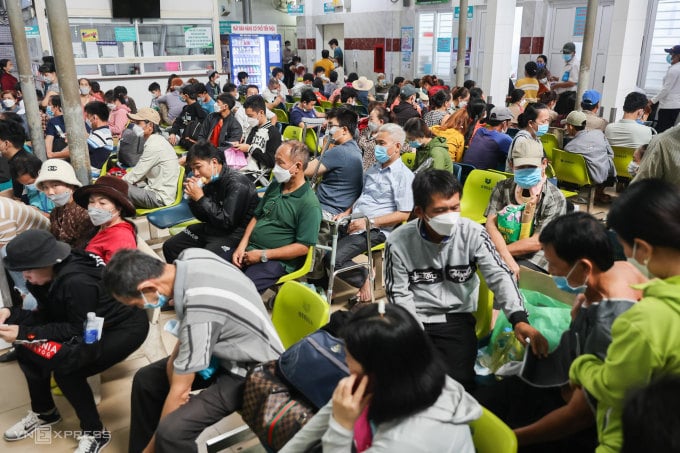The Ministry of Health has proposed a roadmap to increase health insurance (HI) contributions by increasing the contribution rate from 2025 to reach a maximum of 6% of the basic salary or monthly salary by 2035.
The current health insurance contribution rate is determined as a percentage of the monthly salary used to pay social insurance, pension, unemployment benefits or basic salary depending on the participating group, currently 4.5% and maximum 6%.
The Ministry of Health is seeking comments on the draft revised Law on Health Insurance. In the Law Policy Impact Assessment Report, the Ministry said that the above contribution level is not commensurate with the level of benefits. Meanwhile, the total expenditure of the Health Insurance Fund is always higher each year than the previous year and the need to expand the scope of payment is increasing. In the coming years, the Fund will increase expenditure due to the implementation of the correct calculation of the full price of medical services, while the law does not have a mechanism and roadmap to gradually increase the contribution level.

Working hours of medical staff at Children's Hospital 2 (HCMC), July 2023. Photo: Nhu Quynh
Based on the above reality, the Ministry of Health proposes three options to gradually increase the contribution level to suit the scope of health insurance benefits and the medical examination and treatment needs of participants.
Option one , keep the current maximum contribution rate of 6% but include a roadmap for increasing the contribution rate in the revised law. Specifically, from January 1, 2025, the contribution rate will increase to 5.1% of the monthly salary used to calculate the social insurance contribution of employees, unemployment benefits or basic salary, depending on the participating group. From January 1, 2035, the contribution rate will increase to 6% of the employee's monthly salary.
According to the Ministry of Health, this plan helps increase the Health Insurance Fund, medical facilities have more funding, increase people's rights to medical examination and treatment, access to services as well as treatment effectiveness.
However, this roadmap also increases expenditures for the state budget, businesses, households and workers. According to statistics from the Vietnam Social Security in 2021, with the current contribution rate of 4.5% of the basic salary, the budget is spending nearly 42,300 billion VND. Increasing the contribution rate to 5.1%, the state budget spends an additional 5,700 billion VND per year and nearly 14,100 billion VND if the health insurance contribution rate increases to 6%.
For businesses, health insurance contributions in 2021 will reach VND29,200 billion. If the contribution rate increases to 5.1% of employees' monthly salary, businesses will pay an additional VND3,900 billion and increase by more than VND9,730 billion if the contribution rate is 6%.
Option two , the maximum contribution rate remains at 6% as in the current law, but the roadmap increases with a higher rate. Specifically, from January 1, 2025, the contribution rate increases to 5.4% of the employee's monthly salary, unemployment benefits or basic salary, depending on the participating group. From January 1, 2035, the contribution rate increases to 6%.
Similar to the first option, this roadmap also increases the costs of the state budget, businesses, workers and households. Specifically, if the contribution rate increases to 5.4% in 2025, the state budget will spend an additional VND8,500 billion; businesses will spend more than VND5,840 billion; workers will spend VND2,920 billion more and households will spend nearly VND4,870 billion more.
Option three maintains the current regulation of the maximum contribution rate of 6%, without taking into account the roadmap for increase, but leaves it to the Government to stipulate when necessary. This option does not increase social costs, but it is difficult for the Government to decide when to increase because the law does not stipulate. Medical facilities face a cost burden in the context of increasing number of people using health insurance, the Health Insurance Fund may lose its revenue and expenditure balance.

People receive medical examination and treatment at Ho Chi Minh City Orthopedic Hospital at the end of 2022. Photo: Nhu Quynh
After assessing the pros and cons, the Ministry of Health chose option three because it would not increase expenditure from the state budget, enterprises, or support for workers' relatives. The increase roadmap like the first two options will be considered in the next general revision of the Law on Health Insurance when socio-economic conditions and research time are sufficient.
The revised Law on Health Insurance is expected to be submitted to the National Assembly at the May 2024 session and take effect from January 1, 2025. By the end of 2023, the country will have nearly 93.7 million people participating in health insurance, covering over 93% of the population. Vietnam aims to cover over 95% of the population with health insurance by 2025.
Phuong Ha
Source link







![[Photo] Closing of the 11th Conference of the 13th Central Committee of the Communist Party of Vietnam](https://vstatic.vietnam.vn/vietnam/resource/IMAGE/2025/4/12/114b57fe6e9b4814a5ddfacf6dfe5b7f)






















![[Photo] Overcoming all difficulties, speeding up construction progress of Hoa Binh Hydropower Plant Expansion Project](https://vstatic.vietnam.vn/vietnam/resource/IMAGE/2025/4/12/bff04b551e98484c84d74c8faa3526e0)































































Comment (0)